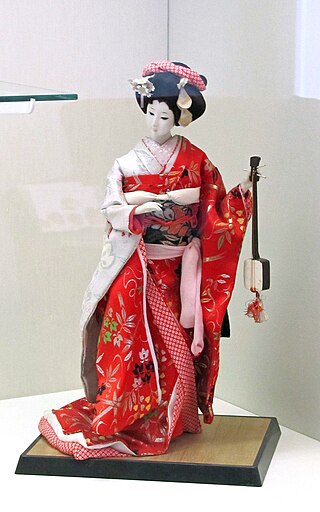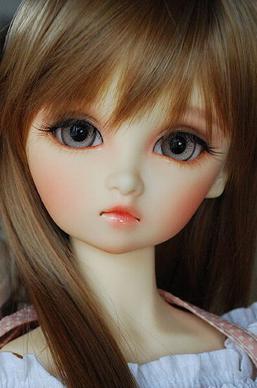
A toy or plaything is an object that is used primarily to provide entertainment. Simple examples include toy blocks, board games, and dolls. Toys are often designed for use by children, although many are designed specifically for adults and pets. Toys can provide utilitarian benefits, including physical exercise, cultural awareness, or academic education. Additionally, utilitarian objects, especially those which are no longer needed for their original purpose, can be used as toys. Examples include children building a fort with empty cereal boxes and tissue paper spools, or a toddler playing with a broken TV remote. The term "toy" can also be used to refer to utilitarian objects purchased for enjoyment rather than need, or for expensive necessities for which a large fraction of the cost represents its ability to provide enjoyment to the owner, such as luxury cars, high-end motorcycles, gaming computers, and flagship smartphones.

A doll is a model typically of a human or humanoid character, often used as a toy for children. Dolls have also been used in traditional religious rituals throughout the world. Traditional dolls made of materials such as clay and wood are found in the Americas, Asia, Africa and Europe. The earliest documented dolls go back to the ancient civilizations of Egypt, Greece, and Rome. They have been made as crude, rudimentary playthings as well as elaborate art. Modern doll manufacturing has its roots in Germany, from the 15th century. With industrialization and new materials such as porcelain and plastic, dolls were increasingly mass-produced. During the 20th century, dolls became increasingly popular as collectibles.

An action figure is a poseable character model figure made most commonly of plastic, and often based upon characters from a film, comic book, military, video game or television program; fictional or historical. These figures are usually marketed toward boys and adult collectors. The term was coined by Hasbro in 1964 to market G.I. Joe to boys.

Matryoshka dolls, also known as stacking dolls, nesting dolls, Russian tea dolls, or Russian dolls, are a set of wooden dolls of decreasing size placed one inside another. The name matryoshka, literally 'little matron', is a diminutive form of Matryosha (Матрёша), in turn a diminutive of the Russian female first name Matryona (Матрёна).

A bobblehead, also known by nicknames such as nodder, wobbler, or wacky wobbler, is a type of small collectible figurine. Its head is often oversized compared to its body. Instead of a solid connection, its head is connected to the body by a spring or hook in such a way that a light tap will cause the head to move around, or "bobble," hence the name.

Japanese dolls are one of the traditional Japanese crafts.

Biscuit porcelain, bisque porcelain or bisque is unglazed, white porcelain treated as a final product, with a matte appearance and texture to the touch. It has been widely used in European pottery, mainly for sculptural and decorative objects that are not tableware and so do not need a glaze for protection.

Peg wooden dolls, also known as Dutch dolls, are a type of wooden doll from South Tyrol. They originated as simple lathe-turned dolls from the Val Gardena in the Alps. The name Pennywoods is also used for dolls of this type, in particular those made in the United States. These dolls were sold undressed. Children would then make their clothing from scraps of fabric.

Fashion dolls are dolls primarily designed to be dressed to reflect fashion trends. They are manufactured both as toys for children to play with and as collectibles for adults. The dolls are usually modeled after teen girls or adult women, though child, male, and even some non-human variants exist. Contemporary fashion dolls are typically made of vinyl or another plastic.

Army men, or plastic soldiers, are toy soldiers that are about 5 cm (2.0 in) tall and most commonly molded from low-density polyethylene plastic, which makes them durable and flexible. Unlike the more expensive toy soldiers available in hobby shops, army men are sold at low prices in discount stores and supermarkets. Army men are traditionally solid green or tan and almost always dressed in modern military uniforms and armed with 20th-century weapons. 'Jumbo' army men are a less common secondary scale with 4.75-inch (12.1 cm) soldiers made by the same process.

A ball-jointed doll is any doll that is articulated with ball and socket joints. In contemporary usage when referring to modern dolls, and particularly when using the acronyms BJD or ABJD, it usually refers to modern Asian ball-jointed dolls. These are cast in polyurethane synthetic resin, a hard, dense plastic, and the parts strung together with a thick elastic. They are predominantly produced in Japan, South Korea and China. The BJD style has been described as both realistic and influenced by anime. They commonly range in size from about 60 centimetres (24 in) for the larger dolls, 40 cm (15.5 in) for the mini dolls, and down to 10 cm (4 in) for the very smallest BJDs. BJDs are primarily intended for adult collectors and customizers. They are made to be easy to customize, by painting, changing the eyes and wig, and so forth.

Topper Corporation was a United States toy and board game manufacturer based in Elizabeth, New Jersey. The company, founded and run by Henry Orenstein, a holocaust survivor, produced toys under several brand names including: Johnny Lightning, Johnny Seven OMA, Dawn doll, and Suzy Homemaker.

A china doll is a doll made partially or wholly out of glazed porcelain. The name comes from china being used to refer to the material porcelain. Colloquially the term china doll is sometimes used to refer to any porcelain or bisque doll, but more specifically it describes only glazed dolls.

A bisque doll or porcelain doll is a doll made partially or wholly out of bisque or biscuit porcelain. Bisque dolls are characterized by their realistic, skin-like matte finish. They had their peak of popularity between 1860 and 1900 with French and German dolls. Bisque dolls are collectible, and antique dolls can be worth thousands of dollars. Antique German and French bisque dolls from the 19th century were often made as children's playthings, but contemporary bisque dolls are predominantly made directly for the collectors market.

A composition doll is a doll made partially or wholly out of composition, a composite material composed of sawdust, glue, and other materials such as cornstarch, resin and wood flour. The first composition dolls were made in the 19th century.

Kewpie is a brand of dolls and figurines that were conceived as comic strip characters by cartoonist Rose O'Neill. The illustrated cartoons, appearing as baby cupid characters, began to gain popularity after the publication of O'Neill's comic strips in 1909, and O'Neill began to illustrate and sell paper doll versions of the Kewpies. The characters were first produced as bisque dolls in Waltershausen, Germany, beginning in 1912, and became extremely popular in the early 20th century.

Penny toys is a name used for inexpensive tin toys mostly manufactured in Germany between the 1880s and 1914 that were sold in the UK, Europe and America in the late 19th century and early 20th century.
Patti Playpal, also spelled as Patti Play Pal, was an American line of dolls created by both Neil Estern and Vincent DeFilippo both versions were produced by the Ideal Toy Company during the late 1950s to early 1960s. The dolls head, arms, legs and torso are made from vinyl. The process used for the torso and legs is known as blow molding.
The American Character Doll Company was an American toy company specializing in dolls. Their most popular dolls included "Tiny Tears," "Tressy," "Butterball Doll", "Sweet Sue," and "Toodles." Founded in 1919, the company's fortunes peaked in the mid-20th century, as they sold millions of dolls exclusively to retailers and mail-order houses such as Sears and Montgomery Ward. The company was the first to produce mass-marketed rubber dolls in the United States. American Character Dolls went bankrupt in 1968, with their assets acquired by the Ideal Toy Company.

















